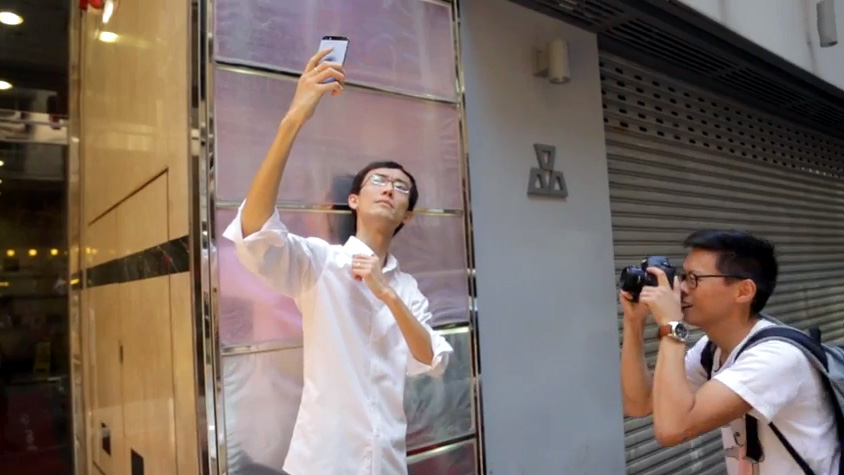Kai from DigitalRev describes the 8 things that you’re likely to encounter as a street photographer and gives his advice on how to handle them. The tongue-in-cheek video is definitely entertaining but he makes a lot of points that are worth discussion. Hit the jump for the full video and our analysis.
Kai’s videos are often dismissed for their fun and quirky style. But he offers solid advice for handling everything from finding inspiration to avoiding confrontation and his points make a great starting point for a larger discussion. Let’s have a closer look.
1 – Unsinpiring Location
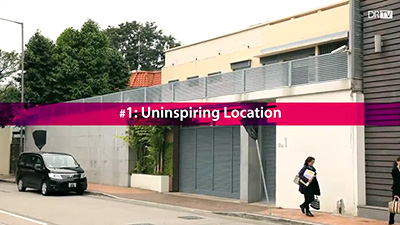
According to Kai, shooting in an uninteresting area is “as difficult as trying to eat nutty fecal matter.” He suggests just going somewhere more interesting and get on with it.
No doubt it’s easier to shoot in a location where tons of interesting things are happening. This is why I’m usually so shutter happy on the first day of any vacation or trip. It’s all new and different and inspiring. But beautiful images can happen anywhere and the real challenge is to be ready to shoot wherever you are. Don’t go “somewhere” to take pictures then blame the location if there’s no inspiration. Be ready to photograph because something interesting is happening where you are.
I’d say make the act of shooting less of a destination and more of an event.
2 – Street Photography Stage Fright
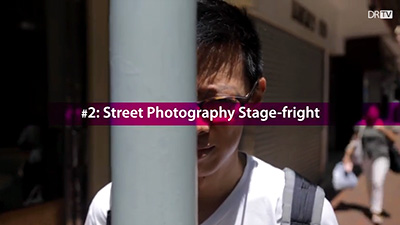
The biggest barrier to shooting on the street is the fear of shooting on the street. But why are you afraid? Is it fear of confrontation? Do you feel you’re violating someone’s privacy? Kai doesn’t really answer this question.
The way I see it, most people don’t encounter fear when taking a picture of their friends, family or pets. And photographing on the street is no different. You’re simply using a photo-mechanical device to capture light reflected off a subject. Do you get nervous if you’re taking a picture of a building? Or a flower? Probably not.
I think a lot of photographing on the street carries some stigma because the media has villified photography. Be it papparazi, terrorist threats or a wide variety of other reasons there’s a growing sense that you’re just “not supposed” to take pictures in public. And to do so means you lack some kind of moral sense of right and wrong. Of course, it’s entirely legal and without moral objections. Might be time to get over this!
Get out there and practice the craft. Start with street portraits – walk up to strangers and compliment them on their jacket or hat. Ask them if you can take their picture. If they agree take the best pic you can and show it to them to see what they think. Practice this for a bit and the fear of shooting strangers will slowly go away. Then you can move on to some more candid shots.
A great place to start with candid shooting is some kind of event like a parade or a fair. The people at these events are typically used to seeing cameras and understand that pictures are being taken. Let the event be your disguise – you’ll be surprised how quickly you’ll get into the flow of shooting candid shots.
Just remember you’re doing nothing wrong when you photograph on the street. Just take intersting photos!
3 – Subject Knows Your Game
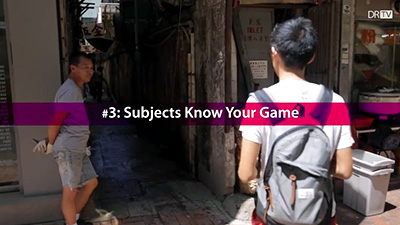
It’s happened to all of us. You raise your camera to photograph something interesting and the subject looks right in the lens then turns away quickly to hide. Or runs out of the frame! Kai suggests you avoid looking dodgy – don’t hide or act suspicious. Look like anyone else on the street then swiftly and subtly get your shot in. Blend in with your surroundings.
The Costa Manos technique is to act like you’re shooting something next to the subject you’re intersted in. The building, the street, the mailbox. Keep an eye on the subject and wait for the moment you’re looking for the move your camera into position. If they notice you slowly move your frame to a new location near by like you’re looking for the best angle. Back and forth until you get the shot you want.
I was able to watch Costa do just this and it was amazing. The subjects would look right at him and he would keep the camera to his eye and trace right or left, up or down like he was looking for a shot. Then move the camera back. If they looked again he would move again. Sure enough the subject would stop paying attention to him and go back to their lives and he could get his shot. Was cool to see it in action – and it totally works!
My technique is a bit more grab and go. I keep my camera ready to go on manual exposure and my lens focussed to hyperfocal distance for a given aperture. If I see a situation that’s interesting I can raise my camera and frame the shot in a split second. Capturing the shot I’m looking for with very little fuss.
Whatever technique you use it’s important to remember that you’re creating an image and not just “taking a picture” of someone on the street. Even the phrase “taking a picture” makes it sound like you’re robbing the subject in some way. They’re definitely in the frame but your job is to make something new as a result of seeing them at the time and place. Find the method that works the best for you!
4 – You Get A New A&*e Orfice Torn
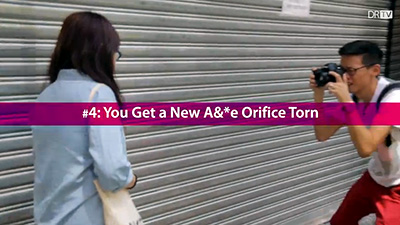
Fear of confrontation is natural and eventually every street photographer will have someone freak out when they realize they’ve been photographed. It’s never easy when this happens but rest assured, it will happen.
Kai simply suggests to apologize and delete the photo. I disagree with this and my policy is to never delete photos. Ever.
Look, photography by its very nature is a passive act. Light has to reflect off something else and travel to your camera for an image to be made. This happens whether or not you’re there so you have not affected the world in any way by photographing the scene. In fact if someone doesn’t want their picture taken they should probably stop reflecting light in the first place!
If someone says, “Don’t take my picure!” I smile and say, “Okay” and go about my business. Typically this isn’t enough for that person and they’ll follow me to claim, “You can’t do that! You need permission!” They’re entirely wrong – depending on where you are in the world you’re entirely within your rights to photograph anyone in any public space. But don’t don’t get caught up in this argument. Don’t try to reason with them. Just say, “Okay.” and move on.
If the person tells me to delete the picture I just say, “I’m sorry, but I won’t do that.”
Things can go a variety of ways here but typically you’re dealing with someone who just needs to assert control on the world because they feel you’ve taken something from them by photographing them. Talk to them. Show them the picture. Tell them you’re an artist and you express yourself by photographing the simple beauty of every day life on the street. Give them a card, offer to send them a copy of the picture. Diffuse the situation. It’s not as hard as it sounds.
This eventually happens to all street photographers – be prepared. Be friendly and polite and assert your right without being argumentative. But if someone pulls a gun, go ahead and delete that pic!
5 – People Stop What They’re Doing
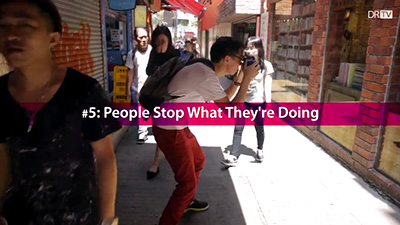
This has happened to all of us. You find an interesting scene or backdrop and set yourself up waiting for someone interesting to walk in the frame. And what happens? People stop at the edge of your frame and wait so they don’t “get in your shot.” I think this is rooted in most people’s understanding of photography as a thing that tourists use to record the places they’ve been.
Kai’s advice is strong here. Don’t camp out with camera ready to take a shot. Watch the scene and wait for something interesting then move your camera into position smoothly so you don’t attract attention to yourself.
But another option would be to avoid this kind of shot altogether. We’ve all seen images of people walking in front of a brightly colored wall and it’s not entirely interesting to start with. People shouldn’t be treated like incidental props to fill the frame. Look for interesting situations and moments that include people and avoid these cheesy tableau scenarios.
6 – Decisive Moment Never Comes
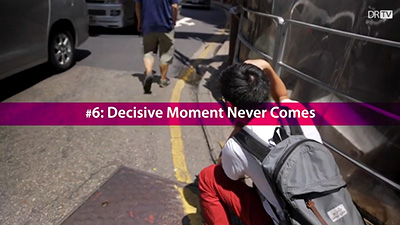
Kai suggests you avoid spending too much time in one location waiting for somethign interseting to happen. Sometimes it’s just better to move along.
I agree with Kai here. Good photos won’t just “come along” becuase you’re standing in a cool spot. Look for situations where excellent photos can be created. Anticipate the moments that might happen but don’t wait for them to walk into your frame.
7 – Worry About Getting The Shot
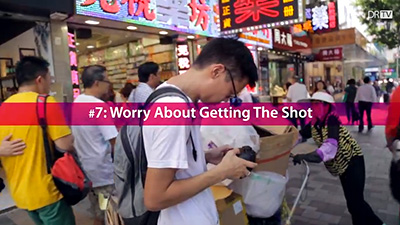
Don’t worry about whether you got the shot when you’re on the street. Stop chimping and keep shooting!
Agreed. If you want to take better pictures then look at your work critically. Ask yourself why a shot fails or succeeds and think about what you could have done differently next time that opportunity comes your way. But the time for this is later when the editing process can be distraction free.
The only thing you can accomplish by checking to see if you got the shot is to actually miss the next shot because you’re checking this one. Relax, and keep shooting!
8 – Quick Shot Bad Exposure
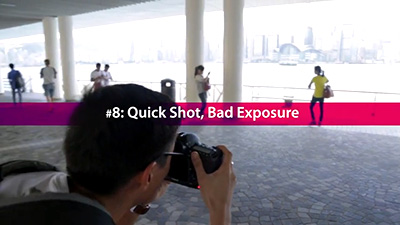
With all the modern whiz-bangery in today’s cameras it’s easy to lose sight of the craft of photography. But good exposure is the first step in the creation of any photograph.
Kai goes over his favorite settings which seem sound. Aperture priority so he can manage depth of field but let the camera control the shutter speed for proper exposure. Center focus point for accurate focus and reframe shooting. But he stresses that you be aware of the light and recognize situations that can foil your camera’s automatic exposure.
I’ve been shooting for a long time so I rarely use any kind of auto exposure. For most situations I can tell the right aperture and shutter speed just by looking at a scene. I carry a light meter and might even shoot a test shot to chim exposure in tricky lighting situations but the camera’s exposure is always locked down. Don’t want anything unexpected and for me knowing what I’m in control of the camera’s exposure works best.
However you set up your camera, take the time to practice and understand the process. You never want to miss a great shot because it’s over/under exposed. Mastering the technical side of photography takes a bit of time but it’s a rewarding process!
Conclusion
I want to thank Kai at DigitalRev for posting this video. His light hearted take on the subject has sparked a lot of ideas that are worth discussing!
Street photography is never smooth sailing and street photographers need to be prepared to handle a wide variety of situations. Time and practice are the best tools you have to make you feel at ease when shooting on the street. If it’s not an enjoyable process then you’re doing something wrong.
How do you handle these situations with your own street photography? Post your ideas in the comments and keep the conversation going!

